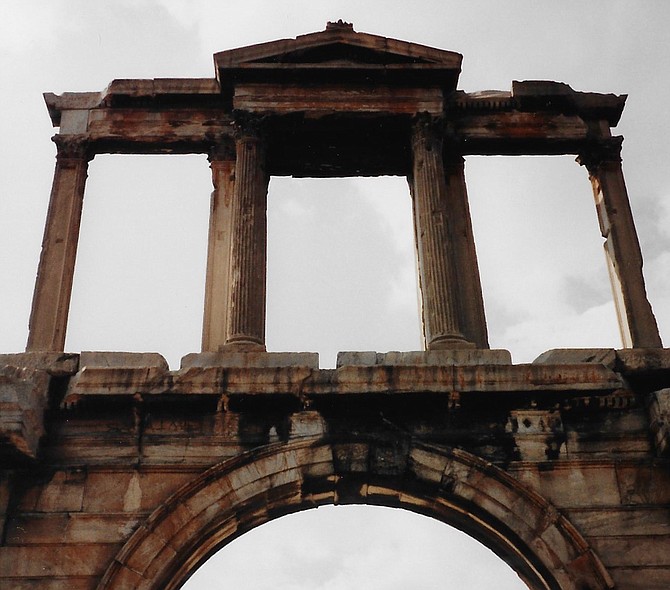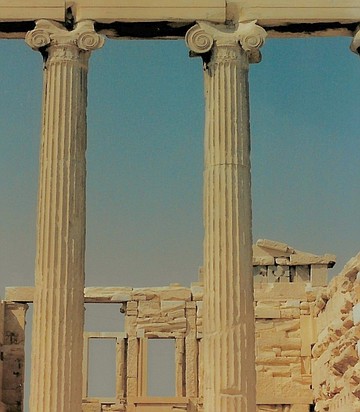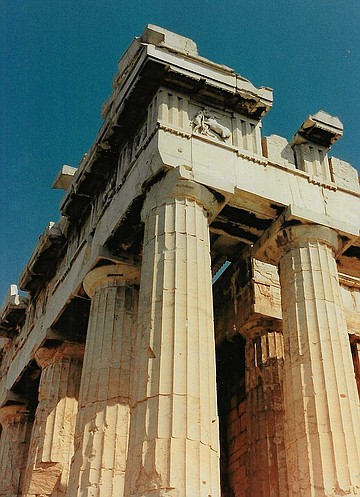 Facebook
Facebook
 X
X
 Instagram
Instagram
 TikTok
TikTok
 Youtube
Youtube

Athens, Greece, is the antidote for the bland. I was inspired by it all – the cultural sites, museums, cuisine, and congenial residents. Athenians are guardians of a rich heritage.
Over two thousand years of history are captured in the antiquities. The soaring columns of the Parthenon, a colorful marble pathway at the Acropolis, a fragment of tile: all have stories to tell. Slabs and chunks of stone that may have been someone’s porch or storefront have untold value. These pieces of the past are a lure for those, like me, who are enchanted by the mysteries of antiquity.

My two traveling companions and I enjoyed a sweeping view of the Acropolis from our hotel room at the Diviani Caravel. This was my first glimpse of the treasures of Athens. Throughout the week, we visited several historical sites and museums, but the glory of them all was the Acropolis. When I marveled at the Parthenon’s curved columns, and the figures in the frieze relief sculptures, I tried to imagine how many others had looked up in wonder.
I think that the Plaka district – the oldest section of the city – is the soul of Athens.

The convoluted cobblestone streets, Byzantine churches, and buildings with terracotta tile roofs drew me in. Some of the structures were crumbling and some had peeling paint, but they all exuded an artistic charm. Ruined columns and chunks of ancient edifices stood next to pristine pastel-hued buildings.
Modern-day Plaka was actually built around ruins, mostly of the Agora, which was a gathering place with shops and markets – not unlike today’s Plaka.
Yes, the Plaka has streams of tourists and an overabundance of souvenir shops, but it is also a gathering place for locals. When the locals meet, they do what we did – they shop, eat, drink and laugh. As tourists, we merged with the crowd of shoppers who descended upon the Plaka in a whir of excitement. In the narrow alleys we found too much graffiti, but the fascinating shops and colorful sidewalk cafes made up for it.
Our first evening in Athens, echoes of laughter and enticing aromas drew us to a restaurant on Adrianou Street. I searched the menu until I found the traditional Greek entrée, moussaka. It was a moist, savory dish of eggplant layered with ground lamb, seasoned with exotic spices, then drenched in a creamy béchamel sauce.
Instead of dessert, I ordered dolomades – stuffed grape leaves – just because I thought I should eat dolomades in Athens. I am glad I did. The earthy flavor was a wonderful taste surprise.
After dinner, we walked back to our hotel past the massive Olympic Stadium, Hadrian’s Arch, and the Temple of Zeus. I cannot describe the exhilaration of seeing three historic sites in one evening’s walk.
The next day, we dined at Kalokairinós, one of the oldest tavernas in Athens, known for its colorful folk dancers. That is where I was introduced to ouzo – a potent licorice-flavored alcoholic beverage. Amid lively chatter, this was definitely a place for revelry. Belly dancers swirled around in a cloud of gauze. Male dancers wore traditional Greek costumes complete with “fustanella,” which are pleated kilt-like garments. The toes of their shoes were adorned with black pom-poms that shook and quivered as the men twirled and stomped around the stage. At the show’s finale, the audience thanked the performers by shouting a hearty “Efharisto”!

My friends and I liked the Plaka so much that we decided to move to an intriguing Plaka hotel for our last three nights in Athens. It was a 19th century structure with flaking paint, no lift, and narrow winding stairs to our room on the second floor. The enchanting room had 12-foot ceilings and a blue tile fireplace. A small black iron balcony afforded a view of the Acropolis.
We asked our host what restaurant he preferred, then we headed to a sidewalk café not far from our hotel. It was a bit early for the dinner crowd, so the café was quiet and uncrowded. Lilting strains of bouzouki music drifted through the air.
Our server recommended the souvlaki, which was flame-grilled lamb layered in fresh-made pita bread, then smothered with grilled onions and tomatoes. Home-made tzatziki – yogurt mixed with finely chopped cucumber, onion, and garlic—was slathered on the top. It was a dripping but luscious delight!
We lingered at our sidewalk table, watching people strolling along the narrow street. Some stopped and surveyed vendor carts, which were brimming with candy and nuts. Others fed stray cats that seemed to be a fixture in the Plaka.

We wandered the Plaka for a while, then entered a store where the shopkeeper sold me a gold-plated pendant – a replica of a Byzantine cross coin. He then guided me to a small balcony off the showroom. As the shopkeeper waved his hand in the direction of the Acropolis, he said, “That is the place where Socrates died.” Then he added, “My shop is only a few yards from the school of Socrates.”
He then told me that he feels he is carrying on the legacy of Socrates because of his efforts to help others solve their problems.
“People come to me with problems and I tell them to turn the problem into a question, and then I might be able to help them answer their question.”
As I said goodbye to this modern day philosopher, I felt grateful for people like him who are dedicated to helping others. It was also a comfort to know that, amidst our changing world, there are some things that remain the same. Things like ancient Greek monuments and modern Greek philosophers.
Greece is welcoming U.S. travelers, but please visit the U.S. Embassy in Greece website for current entry information:
gr.usembassy.gov/u-s-citizen-services/security-and-travel-information/.


Athens, Greece, is the antidote for the bland. I was inspired by it all – the cultural sites, museums, cuisine, and congenial residents. Athenians are guardians of a rich heritage.
Over two thousand years of history are captured in the antiquities. The soaring columns of the Parthenon, a colorful marble pathway at the Acropolis, a fragment of tile: all have stories to tell. Slabs and chunks of stone that may have been someone’s porch or storefront have untold value. These pieces of the past are a lure for those, like me, who are enchanted by the mysteries of antiquity.

My two traveling companions and I enjoyed a sweeping view of the Acropolis from our hotel room at the Diviani Caravel. This was my first glimpse of the treasures of Athens. Throughout the week, we visited several historical sites and museums, but the glory of them all was the Acropolis. When I marveled at the Parthenon’s curved columns, and the figures in the frieze relief sculptures, I tried to imagine how many others had looked up in wonder.
I think that the Plaka district – the oldest section of the city – is the soul of Athens.

The convoluted cobblestone streets, Byzantine churches, and buildings with terracotta tile roofs drew me in. Some of the structures were crumbling and some had peeling paint, but they all exuded an artistic charm. Ruined columns and chunks of ancient edifices stood next to pristine pastel-hued buildings.
Modern-day Plaka was actually built around ruins, mostly of the Agora, which was a gathering place with shops and markets – not unlike today’s Plaka.
Yes, the Plaka has streams of tourists and an overabundance of souvenir shops, but it is also a gathering place for locals. When the locals meet, they do what we did – they shop, eat, drink and laugh. As tourists, we merged with the crowd of shoppers who descended upon the Plaka in a whir of excitement. In the narrow alleys we found too much graffiti, but the fascinating shops and colorful sidewalk cafes made up for it.
Our first evening in Athens, echoes of laughter and enticing aromas drew us to a restaurant on Adrianou Street. I searched the menu until I found the traditional Greek entrée, moussaka. It was a moist, savory dish of eggplant layered with ground lamb, seasoned with exotic spices, then drenched in a creamy béchamel sauce.
Instead of dessert, I ordered dolomades – stuffed grape leaves – just because I thought I should eat dolomades in Athens. I am glad I did. The earthy flavor was a wonderful taste surprise.
After dinner, we walked back to our hotel past the massive Olympic Stadium, Hadrian’s Arch, and the Temple of Zeus. I cannot describe the exhilaration of seeing three historic sites in one evening’s walk.
The next day, we dined at Kalokairinós, one of the oldest tavernas in Athens, known for its colorful folk dancers. That is where I was introduced to ouzo – a potent licorice-flavored alcoholic beverage. Amid lively chatter, this was definitely a place for revelry. Belly dancers swirled around in a cloud of gauze. Male dancers wore traditional Greek costumes complete with “fustanella,” which are pleated kilt-like garments. The toes of their shoes were adorned with black pom-poms that shook and quivered as the men twirled and stomped around the stage. At the show’s finale, the audience thanked the performers by shouting a hearty “Efharisto”!

My friends and I liked the Plaka so much that we decided to move to an intriguing Plaka hotel for our last three nights in Athens. It was a 19th century structure with flaking paint, no lift, and narrow winding stairs to our room on the second floor. The enchanting room had 12-foot ceilings and a blue tile fireplace. A small black iron balcony afforded a view of the Acropolis.
We asked our host what restaurant he preferred, then we headed to a sidewalk café not far from our hotel. It was a bit early for the dinner crowd, so the café was quiet and uncrowded. Lilting strains of bouzouki music drifted through the air.
Our server recommended the souvlaki, which was flame-grilled lamb layered in fresh-made pita bread, then smothered with grilled onions and tomatoes. Home-made tzatziki – yogurt mixed with finely chopped cucumber, onion, and garlic—was slathered on the top. It was a dripping but luscious delight!
We lingered at our sidewalk table, watching people strolling along the narrow street. Some stopped and surveyed vendor carts, which were brimming with candy and nuts. Others fed stray cats that seemed to be a fixture in the Plaka.

We wandered the Plaka for a while, then entered a store where the shopkeeper sold me a gold-plated pendant – a replica of a Byzantine cross coin. He then guided me to a small balcony off the showroom. As the shopkeeper waved his hand in the direction of the Acropolis, he said, “That is the place where Socrates died.” Then he added, “My shop is only a few yards from the school of Socrates.”
He then told me that he feels he is carrying on the legacy of Socrates because of his efforts to help others solve their problems.
“People come to me with problems and I tell them to turn the problem into a question, and then I might be able to help them answer their question.”
As I said goodbye to this modern day philosopher, I felt grateful for people like him who are dedicated to helping others. It was also a comfort to know that, amidst our changing world, there are some things that remain the same. Things like ancient Greek monuments and modern Greek philosophers.
Greece is welcoming U.S. travelers, but please visit the U.S. Embassy in Greece website for current entry information:
gr.usembassy.gov/u-s-citizen-services/security-and-travel-information/.
Comments